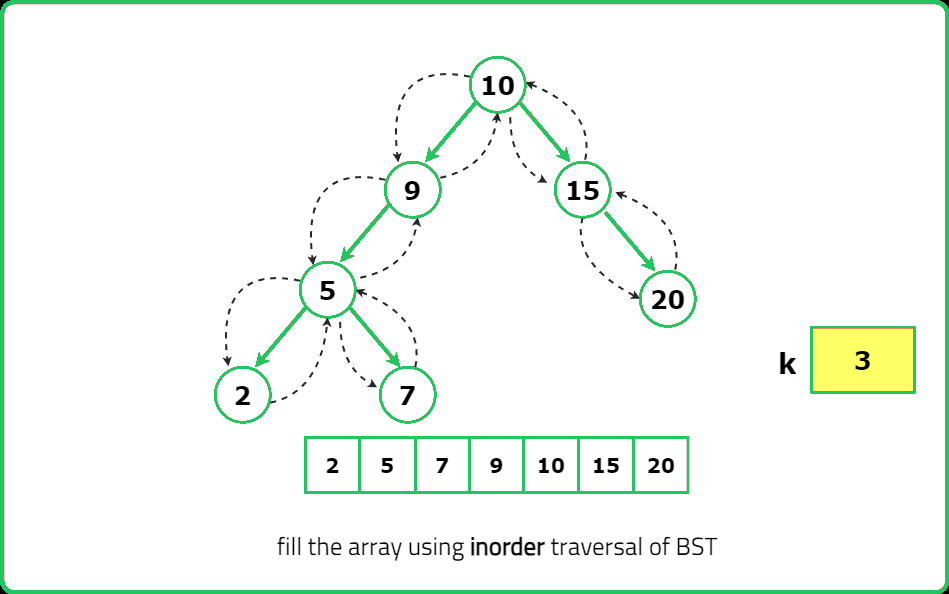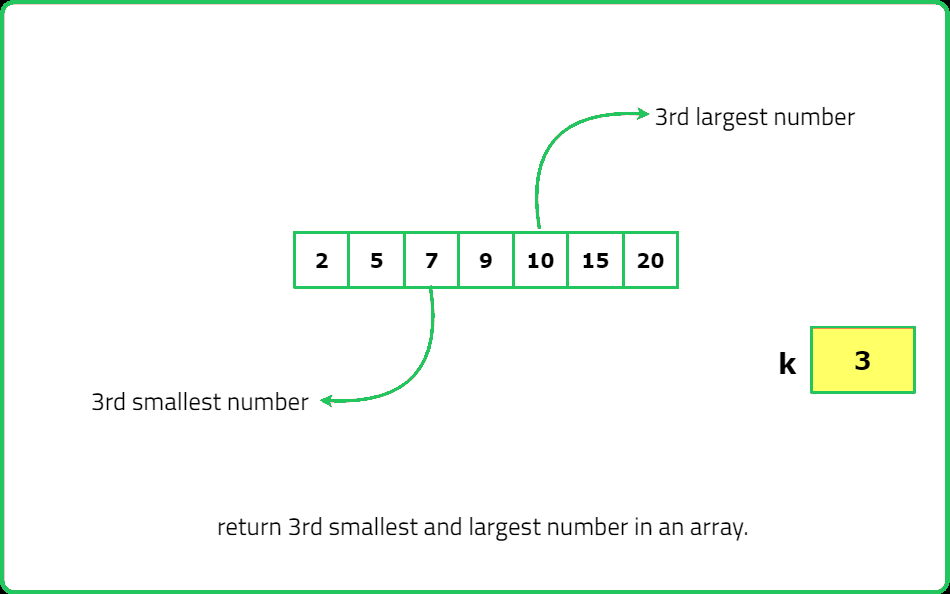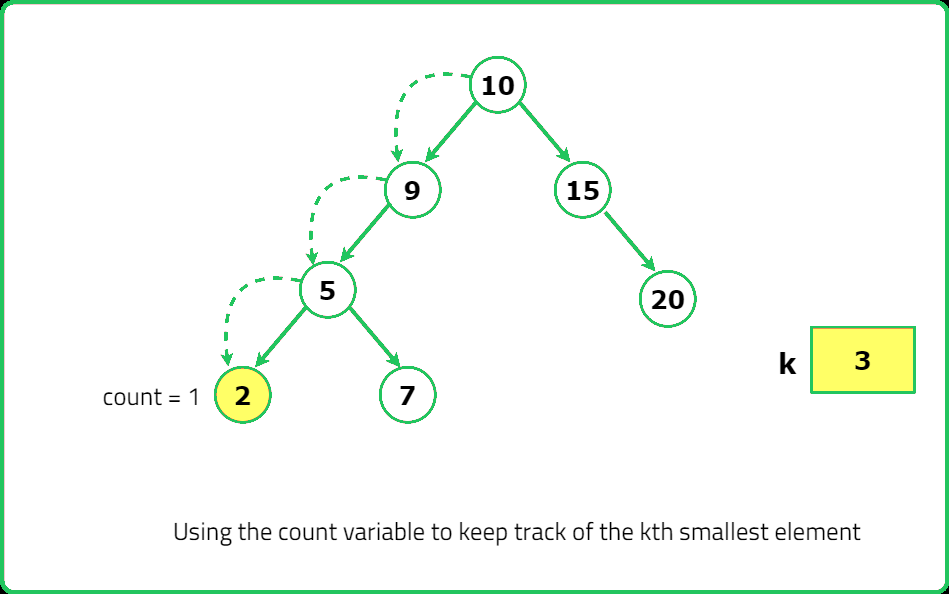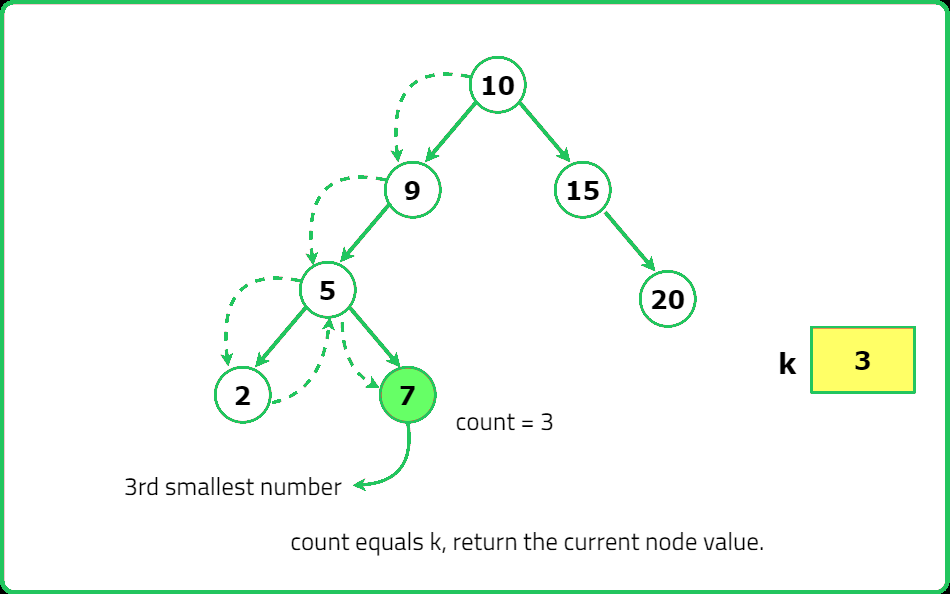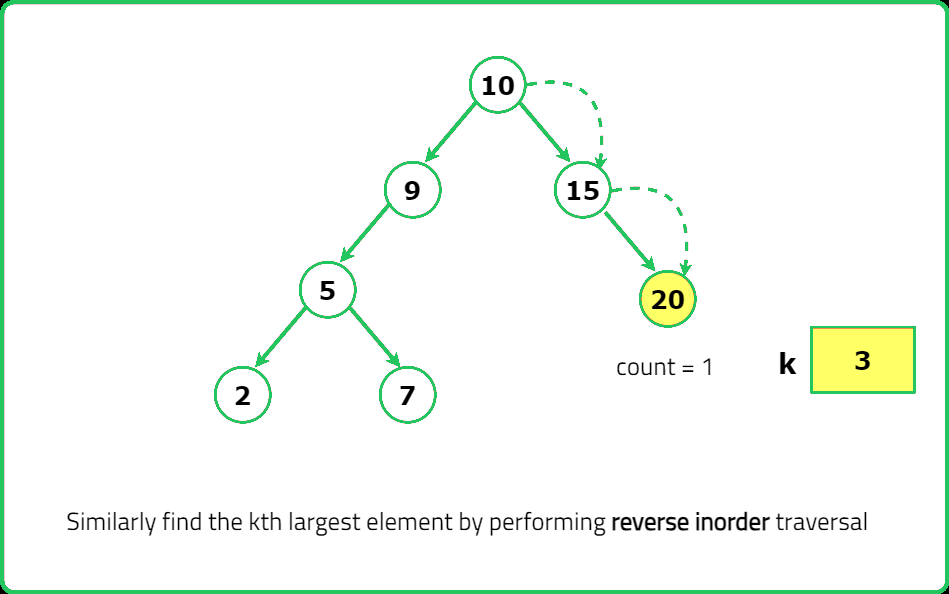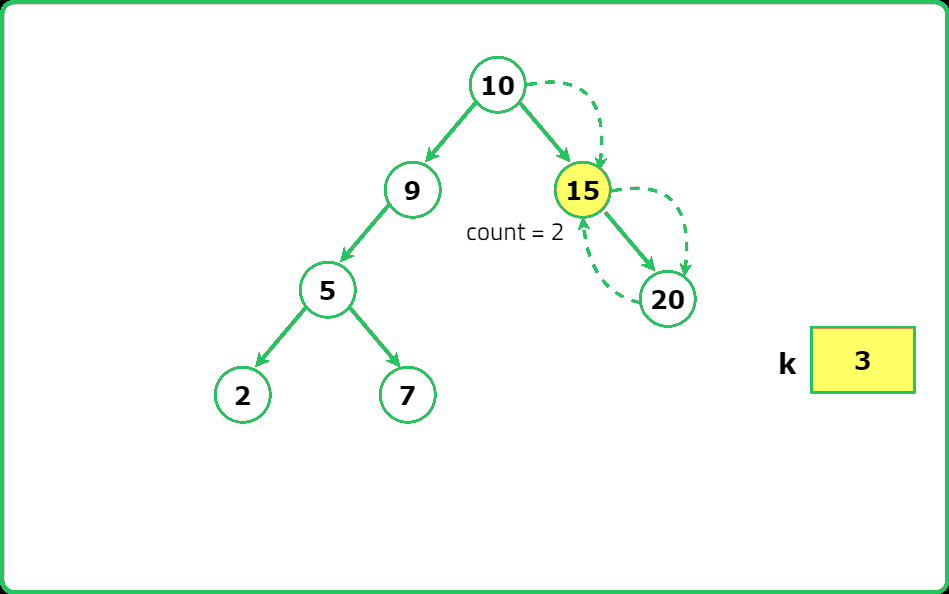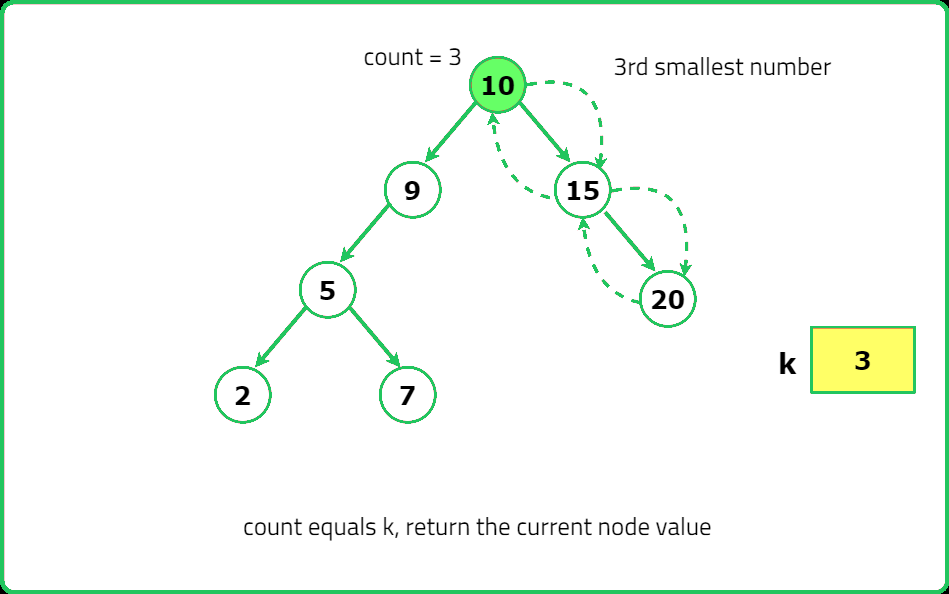123456789101112131415161718192021222324252627282930313233343536373839404142434445464748495051525354555657585960616263646566676869707172737475767778798081828384
#include <bits/stdc++.h>
using namespace std;
// Definition for a binary tree node.
struct TreeNode {
int data;
TreeNode *left;
TreeNode *right;
TreeNode(int val) : data(val), left(nullptr), right(nullptr) {}
};
class Solution {
public:
// Function to find the kth smallest element
int kthSmallest(TreeNode* root, int k) {
this->k = k;
this->result = -1;
inorder(root);
return result;
}
// Function to find the kth largest element
int kthLargest(TreeNode* root, int k) {
this->k = k;
this->result = -1;
reverse_inorder(root);
return result;
}
// Function to return kth smallest and kth largest elements
vector<int> kLargesSmall(TreeNode* root, int k) {
return {kthSmallest(root, k), kthLargest(root, k)};
}
private:
int k;
int result;
// Helper function for inorder traversal
void inorder(TreeNode* node) {
if (node != nullptr) {
inorder(node->left);
if (--k == 0) {
result = node->data;
return;
}
inorder(node->right);
}
}
// Helper function for reverse inorder traversal
void reverse_inorder(TreeNode* node) {
if (node != nullptr) {
reverse_inorder(node->right);
if (--k == 0) {
result = node->data;
return;
}
reverse_inorder(node->left);
}
}
};
// Main method to demonstrate the function
int main() {
// Constructing the tree: [3, 1, 4, nullptr, 2]
TreeNode* root = new TreeNode(3);
root->left = new TreeNode(1);
root->left->right = new TreeNode(2);
root->right = new TreeNode(4);
Solution solution;
int k = 1;
vector<int> result = solution.kLargesSmall(root, k);
// Output the result
cout << "[" << result[0] << ", " << result[1] << "]" << endl; // Output: [1, 4]
return 0;
}
12345678910111213141516171819202122232425262728293031323334353637383940414243444546474849505152535455565758596061626364656667686970717273747576777879808182
import java.util.ArrayList;
import java.util.List;
// Definition for a binary tree node.
public class TreeNode {
int data;
TreeNode left;
TreeNode right;
TreeNode(int val) { data = val; left = null; right = null; }
}
class Solution {
private int k;
private int result;
// Function to find the kth smallest element
public int kthSmallest(TreeNode root, int k) {
this.k = k;
this.result = -1;
inorder(root);
return result;
}
// Helper function for inorder traversal
private void inorder(TreeNode node) {
if (node != null) {
inorder(node.left);
if (--k == 0) {
result = node.data;
return;
}
inorder(node.right);
}
}
// Function to find the kth largest element
public int kthLargest(TreeNode root, int k) {
this.k = k;
this.result = -1;
reverseInorder(root);
return result;
}
// Helper function for reverse inorder traversal
private void reverseInorder(TreeNode node) {
if (node != null) {
reverseInorder(node.right);
if (--k == 0) {
result = node.data;
return;
}
reverseInorder(node.left);
}
}
// Function to return kth smallest and kth largest elements
public List<Integer> kLargesSmall(TreeNode root, int k) {
List<Integer> result = new ArrayList<>();
result.add(kthSmallest(root, k));
result.add(kthLargest(root, k));
return result;
}
// Main method to demonstrate the function
public static void main(String[] args) {
// Constructing the tree: [3, 1, 4, null, 2]
TreeNode root = new TreeNode(3);
root.left = new TreeNode(1);
root.left.right = new TreeNode(2);
root.right = new TreeNode(4);
Solution solution = new Solution();
int k = 1;
List<Integer> result = solution.kLargesSmall(root, k);
// Output the result
System.out.println(result); // Output: [1, 4]
}
}
123456789101112131415161718192021222324252627282930313233343536373839404142434445464748495051525354555657585960
# Definition for a binary tree node.
class TreeNode(object):
def __init__(self, val=0, left=None, right=None):
self.data = val
self.left = left
self.right = right
class Solution:
# Function to find the kth smallest element
def kthSmallest(self, root, k):
self.k = k
self.result = None
self.inorder(root)
return self.result
# Helper function for inorder traversal
def inorder(self, node):
if node is not None:
self.inorder(node.left)
self.k -= 1
if self.k == 0:
self.result = node.data
return
self.inorder(node.right)
# Function to find the kth largest element
def kthLargest(self, root, k):
self.k = k
self.result = None
self.reverse_inorder(root)
return self.result
# Helper function for reverse inorder traversal
def reverse_inorder(self, node):
if node is not None:
self.reverse_inorder(node.right)
self.k -= 1
if self.k == 0:
self.result = node.data
return
self.reverse_inorder(node.left)
# Function to return kth smallest and kth largest elements
def kLargesSmall(self, root, k):
return [self.kthSmallest(root, k), self.kthLargest(root, k)]
# Example usage
if __name__ == "__main__":
# Constructing the tree: [3, 1, 4, None, 2]
root = TreeNode(3)
root.left = TreeNode(1)
root.left.right = TreeNode(2)
root.right = TreeNode(4)
solution = Solution()
k = 1
result = solution.kLargesSmall(root, k)
print(result) # Output: [1, 4]
1234567891011121314151617181920212223242526272829303132333435363738394041424344454647484950515253545556575859606162636465666768697071727374757677787980818283
// Definition for a binary tree node.
class TreeNode {
constructor(val = 0, left = null, right = null) {
this.data = val;
this.left = left;
this.right = right;
}
}
class Solution {
constructor() {
this.k = 0;
this.result = null;
}
// Function to find the kth smallest element
kthSmallest(root, k) {
this.k = k;
this.result = null;
this.inorder(root);
return this.result;
}
// Helper function for inorder traversal
inorder(node) {
if (node !== null) {
this.inorder(node.left);
this.k -= 1;
if (this.k === 0) {
this.result = node.data;
return;
}
this.inorder(node.right);
}
}
// Function to find the kth largest element
kthLargest(root, k) {
this.k = k;
this.result = null;
this.reverseInorder(root);
return this.result;
}
// Helper function for reverse inorder traversal
reverseInorder(node) {
if (node !== null) {
this.reverseInorder(node.right);
this.k -= 1;
if (this.k === 0) {
this.result = node.data;
return;
}
this.reverseInorder(node.left);
}
}
// Function to return kth smallest and kth largest elements
kLargesSmall(root, k) {
return [this.kthSmallest(root, k), this.kthLargest(root, k)];
}
}
// Main function to demonstrate the function
function main() {
// Constructing the tree: [3, 1, 4, null, 2]
let root = new TreeNode(3);
root.left = new TreeNode(1);
root.left.right = new TreeNode(2);
root.right = new TreeNode(4);
let solution = new Solution();
let k = 1;
let result = solution.kLargesSmall(root, k);
// Output the result
console.log(result); // Output: [1, 4]
}
main();
